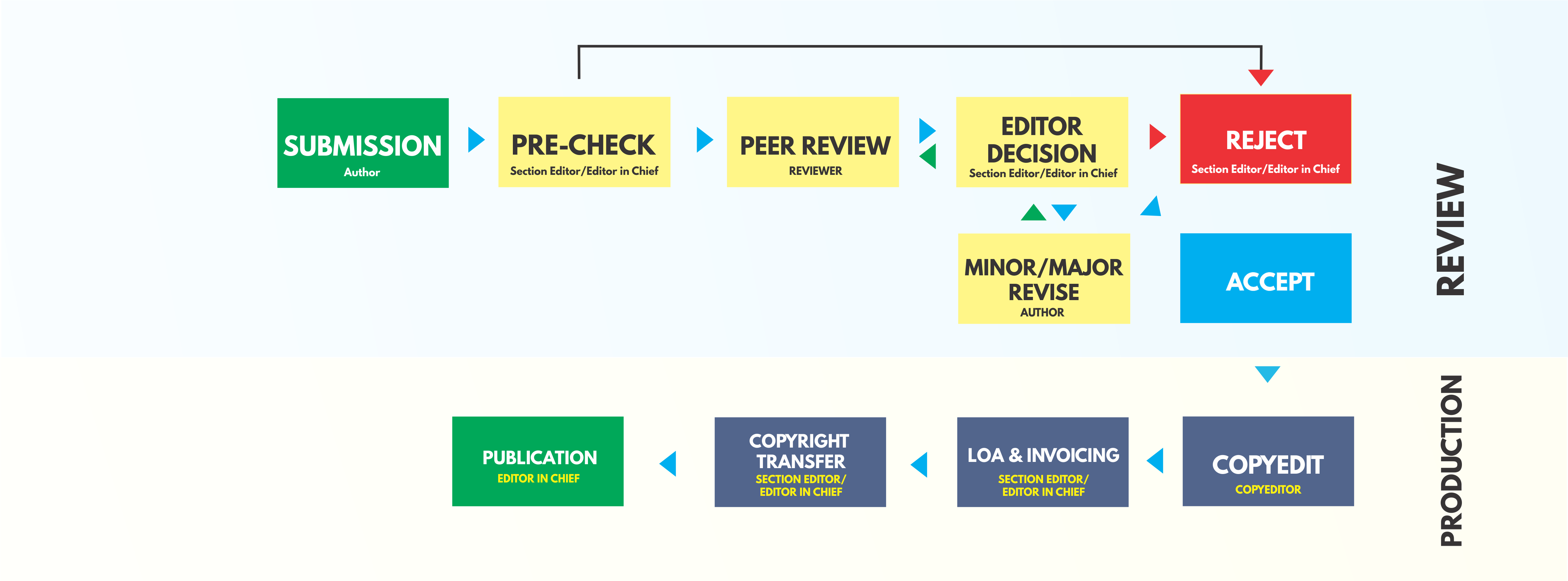Ideasakti: Jurnal Pendidikan operates a rigorous and transparent peer-review process that aims to maximize quality. Peer-review is handled by researchers and scholars.
We believe that peer-review needs to be efficient, rigorous, and fair for everyone involved.
In most Ideasakti: Jurnal Pendidikan journals, peer-review is a Double-blind assessment with at least two independent reviewers, followed by a final acceptance/rejection decision by the Editor-in-Chief, or another academic editor approved by the Editor-in-Chief. The Editor-in-Chief is responsible for the academic quality of the publication process, including acceptance decisions, approval of Guest Editors and Special Issue topics, and appointing new Editorial Board members.
A summary of the editorial process is given in the flowchart below.

-
GUIDELINES FOR CAKRAWALA: JURNAL PENDIDIKAN WRITING ARTICLES
- Articles in the form of research or the result of thinking about education research that has not been published in other media.
- The article is written in Indonesian or English form of typing, along with a CD recording a maximum of 18 pages, A4, including tables and figures, spaced 2 (two).
- Digest abstract or not more than 200 words with 3-5 keywords (keywords) .
Writing structured as follows:
- Accompanied Title author's identity and address of the institution / agency writer.
- Followed abstract keywords, a summary of the article contents as outlined in a solid and not a comment or foreword author, containing the problem, objectives, methodology, findings or research contributions, written in English.
- Introduction Load background, problem formulation, purpose, usefulness and theoretical framework of the study.
- Theories and Methods should be described 1) review of related theories 2) the type and design of the study, 3) time and location of research, 4) target and research subject, 5) research procedure, 6) the research instrument with determining the validity and reliability and data collection techniques, and 6) techniques data processing and analysis.
- Results and Discussion All the problems should be no limits.Discussion on problems formulated in the introductory chapter should be clearly defined, systematic, and thorough.
- Conclusions and Recommendations Contains conclusions and suggestions.
References should be written according to the literature referenced in the article. So that referred to in the article should be written in the bibliography. Similarly, existing in the bibliography must be referred to in the article.Example Writing Bibliography library materials in the form of books written by the author's name, year of publication, title of book in italics, city of publication, and publisher.To separate the parts used a dot (.), Except between the city and the publisher used a colon (:).
Example
a. From Text Book:
Gronlund, N.E. & Linn, R.L. (1990). Measurement and evaluation in teaching. (6thed.). New York: Macmillan.
b. From Book Chapter:
Effendi, S. (1982). Unsur-unsur penelitian ilmiah. Dalam Masri Singarimbun (Ed.). Metode penelitian survei. Jakarta: LP3ES.
c. From Translation Book:
Daniel, W.W. (1980). Statistika nonparametrik terapan. (Terjemahan Tri Kuntjoro). Jakarta : Gramedia.
d. From final project/thesis/dissertation:
Suyanto, S (2009). Keberhasilan sekolah dalam ujian nasional ditinjau dari organisasi belajar. Disertasi, tidak dipublikasikan. Universitas Negeri Jakarta.
e. From Journal:
Pritchard, P.E. (1992). Studies on the bread-improving mechanism of fungal alpha-amylase. Journal of Biological Education, 26 (1), 14-17.
f. From proceeding:
Paidi. (2008). Urgensi pengembangan kemam-puan pemecahan masalah dan metakog-nitif siswa SMA melalui pembelajaran biologi. Prosiding, Seminar dan Musyawarah Nasional MIPA yang diselenggarakan oleh FMIPA UNY, tanggal 30 Mei 2008. Yogyakarta: Universitas Negeri Yogyakarta.
g. From internet:
Rahmawati, U., & Suryanto, S. (2014). Pengembangan model pembelajaran matematika berbasis masalah untuk siswa SMP. Jurnal Riset Pendidikan Matematika, 1(1), 88-97. Retrieved from http://journal.uny.ac.id/index.php/jrpm/article/view/2667